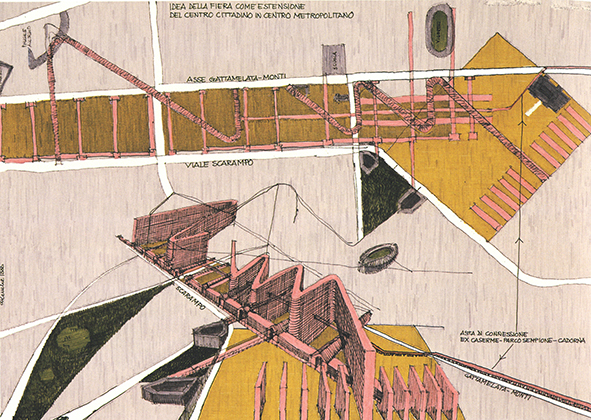Drawings in the world. On multiscalarity and scales outside the representation
DOI:
https://doi.org/10.19229/2464-9309/712020Keywords:
scales, representation, author, mediation, multiscalarityAbstract
The article relates the concept of architectural scale with the philosophical and political implications of the world representation action implicit in every scalar operation. Drawing from a certain philosophical tradition about representation, it follows that the scalar attribution can be interpreted as an attempt to perform a form of control over the represented through the drawing, with the purpose to legitimize the author and the scientificity of the architectural discipline in theories and Schools. However, this paradigm, which made the Italian post-war architecture so successful, is put in crisis by the nature of the problems requiring design and projection. From these considerations, a conceptualization of multiscalarity is proposed, focusing on the project's agency in the world, rather than from an introjection of the latter into the designer intentions.
Downloads
Article Metrics Graph
References
Amirante, R. (2018), Il progetto come prodotto di ricerca – Un’ipotesi, LetteraVentidue, Siracusa.
Aureli, P. V. (2011), The Possibility of an Absolute Architecture, MIT Press, Cambridge (MA).
Boeri, S. (2020a), “The Day After”, in La Repubblica, newspaper, 21 April 2020, p. 19. [Online] Available at: www.stefanoboeriarchitetti.net/wp-content/uploads/2020/04/la-repubblica.ashx_.pdf [Accessed 9 May 2020].
Boeri, S. (2020b), “Da Genova una lezione poderosa ma non automatica per il post Covid-19”, in The Huffigtonpost, newspaper online, 28 April 2020. [Online] Available at: www.huffingtonpost.it/entry/stefano-boeri-da-genova-una-lezione-non-automatica-per-il-post-covid-19_it_5ea8179fc5b6dd3f908aea36 [Accessed 9 May 2020].
Canella, G., Coppa, M., Gregotti, V., Rossi, A., Samonà, A. Scimeni, G., Semerani, L. and Tafuri, M. (1968), Teoria della Progettazione Architettonica, Dedalo, Roma.
Canella, T. (ed.) (2005), Guido Canella – Disegni 1955-2005, Federico Motta, Milano.
Choay, F. (1986), La Regola e il Modello – Sulla Teoria dell’Architettura e dell’Urbanistica [or. ed. La Règle et le Modèle – Sur la Théorie de l’Architecture et de l’Urbanisme, 1980], Officina Edizioni, Roma.
Descartes, R. (2014), Discorso sul metodo [or. ed. Discours de la méthode pour bien conduire sa raison, et chercher la verité dans les sciences – Plus la Dioptrique, les Meteores, et la Geometrie qui sont des essais de cete Méthode, 1637], Einaudi, Torino.
Foucault, M. (2018), Le parole e le cose – Un’archeologia delle scienze umane [or. ed. Les mots et les choses – Une archéologie des sciences humaines, 1966], BUR Rizzoli, Milano.
Galli, C. (2008), Lo sguardo di Giano – Saggi su Carl Schmitt, Il Mulino, Bologna.
Grassi, G. (1967), La costruzione logica dell’architettura, Marsilio, Padova.
Gregotti, V. (2006), “Gli ecomostri dello Zen”, tv interview, in Le Iene, 24 April 2006. [Online] Available at: www.iene.mediaset.it/video/ecomostri-quartiere-zen_532834.shtml [Accessed 13 May 2020].
Gregotti, V. (1965), Il Territorio dell’Architettura, Feltrinelli, Milano.
Heidegger, M. (2002), “L’epoca dell’immagine del mondo” [or. ed. “Die Zeit des Weltbildes”, 1938], in Heidegger, M., Holzwege – Sentieri erranti nella selva, Bompiani, Milano, pp 71-101.
Latour, B. (2013), Cogitamus – Sei lettere sull’umanesimo scientifico [or. ed. Cogitamus – Six Lettres sur les humanités scientifiques, 2010], il Mulino, Bologna.
Latour, B. (2009), Non siamo mai stati moderni [or. ed. Nous n’avons jamais été modernes, 1991], Elèuthera, Milano.
Lovero, P. (1993), “L’architettura e il suo doppio”, in Boudon, P., La questione della scala tra epistemologia e architettura, Istituto Universitario di Architettura di Venezia, Venezia, pp. 2-6.
Massey, D. (2005), For Space, SAGE Publishing.
Rossi, A. (1966), L’Architettura della Città, Marsilio, Padova.
Samonà, G. (1968), “Le scale di progettazione e l’unità nel metodo”, in Canella, G. et alii, Teoria della Progettazione Architettonica, Dedalo, Roma, pp. 101-120.
Tafuri, M. (1968), Teorie e Storie dell’Architettura, Laterza, Roma-Bari.

Downloads
Published
How to Cite
Issue
Section
License
This Journal is published under Creative Commons Attribution Licence 4.0 (CC-BY).
License scheme | Legal code
This License allows anyone to:
Share: copy and redistribute the material in any medium or format.
Adapt: remix, transform, and build upon the material for any purpose, even commercially.
Under the following terms
Attribution: Users must give appropriate credit, provide a link to the license, and indicate if changes were made; users may do so in any reasonable manner, but not in any way that suggests the licensor endorses them or their use.
No additional restrictions: Users may not apply legal terms or technological measures that legally restrict others from doing anything the license permits.
Notices
Users do not have to comply with the license for elements of the material in the public domain or where your use is permitted by an applicable exception or limitation.
No warranties are given. The license may not give users all of the permissions necessary for their intended use. For example, other rights such as publicity, privacy, or moral rights may limit how you use the material.


















































































